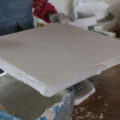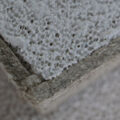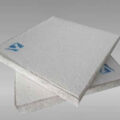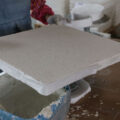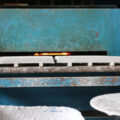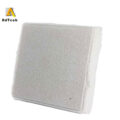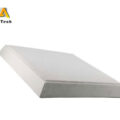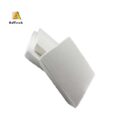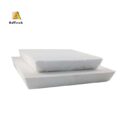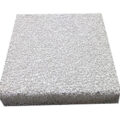Polyurethane sponge, as the raw material for the production of foam ceramics, has a great influence on the performance of foam ceramics, and its influence mainly includes the following aspects.

Impact of Product Shrinkage
The elasticity and strength of the polyurethane sponge carrier have a direct impact on the shrinkage of the foam ceramics, and the impact mainly includes the drying process and the sintering process.
Most ceramic foam filter manufacturers use the double-roll sizing process. The sponge undergoes a certain amount of dimensional extension after being compressed by the double-roller and the slurry is attached. The elongation of the two sides of the inverted web and the straight web is different, and the elongation rate is 1 to 3%. The resilience of the sponge after sizing determines the final size of the dried body. For sponges with good elasticity and high strength, the green body has a small extension size, the slurry is evenly distributed without blind holes, and the sides and thickness are easy to control. For sponges that have poor elasticity, low strength, or cannot meet the sizing of large specific gravity slurry (such as zirconia slurry), the green body will have large size extension after sizing, uneven springback, and poor sizing effect.
The dried green body has a certain strength due to the action of the binder, and the green body is sintered in the kiln after surface spraying and secondary drying. The polyurethane sponge does not volatilize during the drying process, but melts, oozes out of the surface and oxidizes and volatilizes at 200 ~ 600°C during the sintering process. The polyurethane sponge itself is wrapped by the ceramic slurry, and the heat is transferred in through the ceramic slurry, forming an oxygen-free combustion process, causing the sponge to melt, ooze, and finally oxidize and volatilize. The sponge with high strength and good elasticity can make the body shrink slowly. Of course, the sintering temperature and sintering system for foam ceramics of different materials are different.
Product Through Hole Rate
Because polyurethane sponge is used as the carrier for foam ceramic production, the through porosity of the polyurethane sponge itself determines the through porosity of the foam ceramic produced. To obtain a high product through-hole rate, it is necessary to choose the same high through-hole rate polyurethane sponge, and the sponge mesh is required to be uniform, no blind holes, and clear wire distribution. Therefore, the penetration rate and mesh quality of the sponge have a direct impact on the penetration rate and mesh quality of the foam ceramic filter. For example, if you want to produce foam ceramics with a porosity of 82%, you need to choose a polyurethane sponge with a porosity of 85% or more, and the mesh is uniform.
Influence of Product Strength
The properties of polyurethane sponge also have a great influence on the strength of the product, mainly manifested in the influence on the strength of the green body after drying and the influence of the green body strength when the sponge is volatilized during the sintering process.
The influence of the strength of the green body after drying on the final product is mainly manifested in the damage to the green body by the shotcreting operation. The higher the strength of the dried green body, the less damage to it during operation, and the higher the strength of the sintered product. On the contrary, the lower the product strength. The higher the strength and elasticity of the polyurethane sponge, the higher the strength of the body after sizing.
When the polyurethane sponge is sintered and volatilized, the higher the green body strength and the slower the sponge volatilization, the smaller the damage degree and the higher the strength of the product produced. Of course, the main factors affecting the strength of the product are the ceramic slurry material, formula and sintering system.

